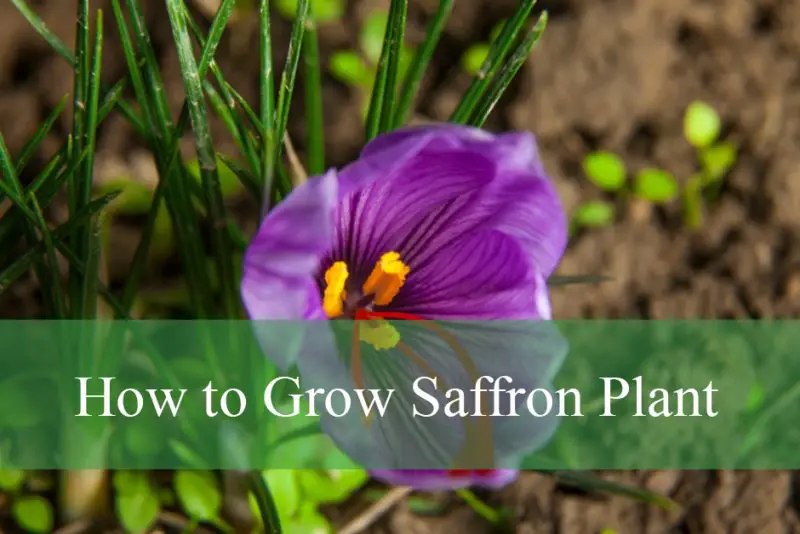Saffron, the world’s most expensive spice, comes from the dried stigmas of the Crocus sativus flower. Though often associated with exotic regions and high-altitude farming, saffron can be cultivated successfully at home with the right techniques and conditions. Growing saffron is not just rewarding in flavor and value but also offers the joy of nurturing a truly unique plant.
Understanding how to grow saffron plant easily with proven tips allows gardeners of all levels to cultivate this precious spice in their own backyard or containers. From selecting quality corms to knowing the best time to harvest, this comprehensive guide provides every essential detail to help you start your own saffron garden with confidence.
Understanding the Saffron Plant and Its Growth Cycle

The saffron plant is a perennial that grows from a corm, similar to a bulb. It produces violet-purple flowers with three bright red stigmas, which are harvested as saffron threads. The Crocus sativus is unique because it blooms in autumn, not spring, and its active growth period occurs during the cooler months of the year.
Once planted, the corm undergoes a dormancy period through the summer and then begins to sprout in the fall. Leaves appear first, followed shortly by flowers. After blooming, the foliage remains green through the winter, gathering energy for the next cycle before dying back by late spring or early summer. Understanding this timing is essential for proper planting, maintenance, and harvest.
Saffron plants require patience, as the first year may yield only a small amount of spice. However, with proper care, saffron corms will multiply underground and produce more flowers in subsequent seasons, offering increasingly generous harvests.
Choosing the Right Location and Soil for Saffron
Saffron thrives in full sunlight and well-draining soil. It prefers loamy or sandy soil that’s rich in organic matter but not overly fertile. The ideal pH range for growing saffron is between 6.0 and 8.0, with slightly alkaline conditions promoting stronger plant growth. Drainage is especially critical, as overly wet soil can cause the corms to rot.
A south-facing spot with good air circulation is ideal for saffron cultivation. In colder climates, raised beds can help prevent waterlogging and improve heat retention. If you’re growing saffron in pots or containers, use a sandy loam mix and ensure the container has ample drainage holes.
Adding compost or aged manure to the soil before planting will enhance its structure and nutrient content. However, avoid nitrogen-heavy fertilizers, as excessive nitrogen can lead to leafy growth at the expense of flowers and stigmas.
Selecting High-Quality Saffron Corms
The quality of your saffron harvest starts with the corms you plant. Healthy, mature corms should be firm, round, and free of mold or blemishes. Typically, larger corms (around 1.5 to 2 inches in diameter) are more likely to produce flowers in their first season. Look for corms that have been stored in dry, well-ventilated conditions and are not showing signs of early sprouting.
Purchasing from a reputable supplier ensures that the corms are disease-free and adapted to your growing zone. Saffron corms are generally planted in late summer or early autumn, so sourcing them early allows you to prepare your site in advance and plant at the optimal time.
Each corm produces one flower in its first year, although larger corms might produce two. As the plant matures, it produces daughter corms underground, allowing the saffron bed to expand and become more productive year after year.
Planting Techniques for Best Results
When planting saffron, spacing is key to encouraging healthy development. Each corm should be planted at a depth of 4 to 6 inches, with around 3 to 4 inches of space between them. This depth helps protect the corms from temperature fluctuations and provides room for daughter corms to form.
Position the corms with their pointed end facing upward and cover them gently with soil. After planting, water the bed lightly to settle the soil around the corms. Avoid overwatering, as saffron prefers dry conditions during dormancy and only requires moderate moisture during the active growing season.
Mulching with a light layer of straw or leaves can help regulate soil temperature and moisture, especially in regions with erratic weather. However, thick or water-retentive mulches should be avoided, as they can contribute to fungal issues.
Watering and Climate Considerations
Saffron is native to the Mediterranean region and prefers a climate with hot, dry summers and cool, wet winters. It requires very little water during its dormancy period and only moderate watering while in active growth. Overwatering can lead to root rot, especially if the soil is not well-drained.
During the autumn and winter growing period, saffron should be watered sparingly—enough to keep the soil moist but never saturated. Container-grown plants should be monitored closely, as they tend to dry out faster than in-ground beds.
In areas with heavy rainfall, protective measures such as raised beds, row covers, or even a low tunnel structure can help prevent water accumulation. In zones with harsh winters (USDA Zone 6 and below), growing saffron in pots that can be brought indoors may be the most viable option.
Managing Weeds and Pests
Weeds compete with saffron plants for nutrients and moisture, which can reduce flower production. Hand-pulling weeds around the plants is the safest method to avoid damaging shallow corms. A light mulch layer can also help suppress weeds naturally without chemicals.
Saffron has relatively few pests, but voles and rodents may dig up and eat the corms. Installing wire mesh or planting in containers can deter burrowing animals. In some areas, fungal diseases such as corm rot can become an issue, particularly in overly wet conditions.
Practicing crop rotation and maintaining good garden hygiene—such as removing dead foliage and debris—helps prevent disease buildup. Avoid planting saffron in the same spot more than three years in a row unless the soil is amended and rested.
Supporting Saffron Growth Through the Seasons
Saffron plants benefit from a natural seasonal rhythm that allows them to thrive with minimal intervention. After flowering in fall, the plant’s thin, grass-like leaves continue to photosynthesize through winter, storing energy in the corms for the next cycle. During this period, it’s important to allow sunlight to reach the foliage and avoid cutting it back prematurely.
By spring, the foliage will begin to yellow and wither. This signals the start of the plant’s dormancy phase. At this point, watering should be stopped, and the area kept dry through summer. If growing in containers, you can move the pots to a dry, shaded location to help the corms rest.
Saffron corms do not need to be dug up every year, but after 3–5 years, they may become crowded. Lifting and dividing them during the summer dormancy period allows you to replant healthy corms and discard any that are damaged or diseased.
Harvesting Saffron Stigmas Properly
The saffron harvest is both brief and delicate. Flowers bloom in the early morning hours, and to capture the highest-quality saffron, the red stigmas should be harvested on the same day the flower opens. Harvesting is best done just after the flower blooms, when the stigmas are bright red and fragrant.
Using clean fingers or tweezers, gently pluck the three red stigmas from each flower. Handle them with care, as bruising can affect the aroma and quality of the final product. After harvesting, allow the stigmas to dry in a warm, shaded place for about 7 to 10 days. They should be completely dry and brittle before storage.
Store dried saffron in an airtight container in a dark, cool location. Properly dried and stored saffron retains its potency for up to two years, although the strongest flavor is usually within the first six to twelve months.
Multiplying Saffron Corms for Future Harvests
One of the key benefits of growing saffron is that the plant propagates itself through corm division. Each year, the mother corm produces several smaller daughter corms that can be harvested and replanted during the dormant summer season. Over time, your saffron plot will expand naturally if managed well.
To propagate successfully, lift the corms during summer after the foliage has fully died back. Gently remove soil, separate the daughter corms, and inspect them for signs of disease or rot. Only healthy, firm corms should be replanted. Before planting them again, cure the corms in a dry, shaded place for a few days to reduce moisture.
Replanting in a new location each year or every few years helps maintain soil health and reduces the risk of disease buildup. With consistent care, your saffron garden will become more productive with each season.
Climate Zones Best Suited for Saffron Cultivation
Saffron can be grown in USDA Zones 6 through 9, with Zone 7 being ideal due to the mild winters and hot summers. In colder climates, container growing allows for more control over temperature and drainage. In hotter regions, some shade during the peak of summer may protect corms from overheating.
If you live in a rainy or humid region, take extra care to ensure drainage is excellent. Growers in tropical climates may struggle with saffron unless they create artificial dormancy by controlling water and temperature.
Each region has its challenges, but with the right environmental modifications—such as raised beds, controlled irrigation, or container planting—most gardeners can successfully grow saffron at home.
Frequently Asked Questions About Growing Saffron
How long does it take for saffron to flower after planting?
Saffron corms typically bloom within 6 to 10 weeks after planting if planted at the right time in late summer. Flowers generally appear in mid to late fall.
Can I grow saffron indoors?
Yes, saffron can be grown indoors in containers if given adequate light and proper temperature conditions. Use well-drained soil, and keep the pots in a cool, sunny location during the growing season.
How many flowers do you need to get 1 gram of saffron?
It takes roughly 150 to 200 flowers to produce 1 gram of dried saffron. Each flower only produces three stigmas, so the process is labor-intensive but incredibly rewarding.
Can I use supermarket saffron to grow plants?
No, supermarket saffron is dried stigmas and does not contain viable corms. To grow saffron, you need Crocus sativus corms sourced from a garden supplier.
Does saffron need fertilizer?
While saffron doesn’t require heavy fertilization, adding compost or well-aged manure to the soil before planting can support strong growth. Avoid synthetic fertilizers rich in nitrogen.
Conclusion
Growing saffron at home may seem intimidating due to its exotic nature, but with the right knowledge and patience, it becomes a highly achievable gardening project. By following the steps outlined in this guide on how to grow saffron plant easily with proven tips, you’ll set the foundation for a thriving saffron patch that can flourish for years.
Whether planted in raised beds or containers, saffron offers the double reward of visual beauty and culinary luxury. With attention to soil, water, climate, and harvesting timing, even novice gardeners can enjoy this ancient spice right from their own backyard.






